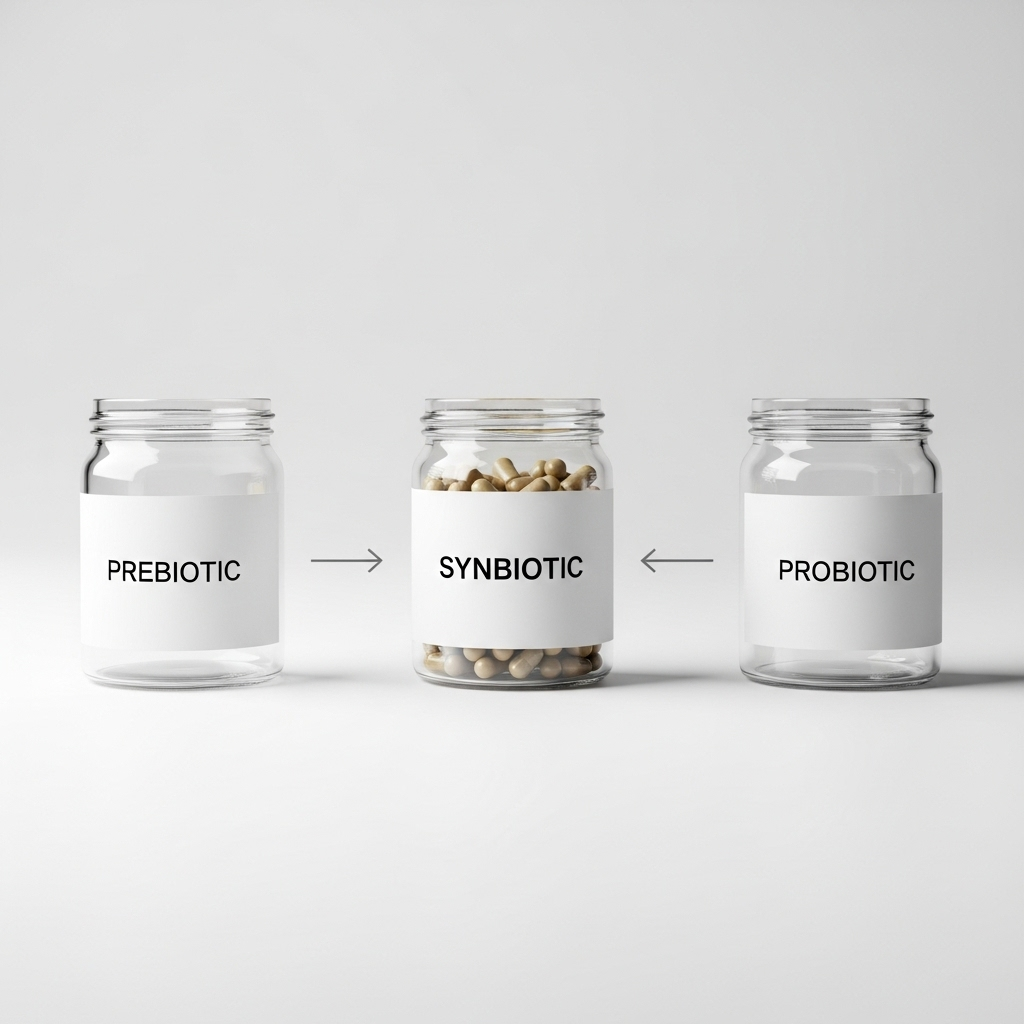Synbiotics for Pets (Prebiotics + Probiotics) Explained

Interest in gut health for dogs and cats is growing, and with it comes the term “synbiotics” — products that combine probiotics (beneficial microorganisms) with prebiotics (food for those microbes). This guide explains synbiotics for pets, how they differ from probiotics alone, evidence for use, how to choose a product, safety considerations, and practical tips for everyday use. It’s written for pet owners who want clear, trustworthy information to discuss with their veterinarian.
What are synbiotics?
Synbiotics are supplements that pair live beneficial microbes (probiotics) with prebiotic ingredients that help those microbes survive, grow, or exert a beneficial effect in the digestive tract. The idea is synergy: the prebiotic supports the probiotic strain(s), improving persistence or activity compared with taking either component alone.
Common probiotic strains used in pets
- Lactobacillus species (e.g., L. acidophilus)
- Bifidobacterium species
- Enterococcus faecium (commonly used in dogs and cats)
- Saccharomyces boulardii (a beneficial yeast)
Common prebiotic ingredients
- Fructooligosaccharides (FOS)
- Mannan-oligosaccharides (MOS)
- Inulin
- Specific fibers such as partially hydrolyzed guar gum
How synbiotics may help pets
Synbiotics are used to support digestive health, immune function, and nutrient utilization. Potential benefits reported in clinical studies or clinical experience include:
- Improved stool consistency and reduced frequency of diarrhea in some cases
- Support during or after a course of antibiotics (by helping repopulate beneficial microbes)
- Support for pets with mild chronic gastrointestinal sensitivity
- Potential support for overall gut barrier function and immune responses
Keep in mind that evidence quality varies by strain, dose, and condition. Not all synbiotics are identical and not all claims are supported by robust clinical trials in dogs or cats.
Choosing a synbiotic for your pet
When evaluating synbiotics for pets, consider these practical factors:
Strain and species specificity
Look for products that list probiotic strains by full name (genus, species, strain ID) and that have evidence supporting use in dogs or cats. Human products are not always appropriate because strains and dosages may differ.
CFU and dosing
CFU (colony-forming units) indicates viable microbes per dose. Effective CFU varies by strain and purpose; more isn’t always better. Follow manufacturer dosing for your pet’s weight and consult your veterinarian for personalized guidance.
Type of prebiotic
Different prebiotics have different effects. FOS and MOS are common in pet products. If your pet has food sensitivities or fiber-sensitive conditions, discuss prebiotic choices with your vet.
Formulation and palatability
Synbiotics come as powders, capsules, chewable tablets, pastes, or treats. Choose a form your pet will reliably take. For picky animals, powders sprinkled on food or flavored chewables may work better.
Quality and storage
Check for clear labeling, expiration date, storage instructions (refrigeration vs. shelf-stable), and whether the company uses third-party testing for potency and contaminants.
Dosage, timing, and administration
General tips:
- Follow label dosing by weight. If unsure, start with the lower end and discuss with your veterinarian.
- Some clinicians recommend giving synbiotics at a different time than antibiotics (for example, 2–3 hours apart) to reduce direct killing of probiotic organisms, though certain formulations are designed to be used with antibiotics.
- For acute diarrhea, many vets suggest a trial of a quality synbiotic for several days to a few weeks; chronic conditions may require longer-term management with veterinary guidance.
Safety, precautions, and who should consult a vet first
Synbiotics are generally safe for healthy dogs and cats, but there are important exceptions and precautions:
- Immunocompromised or severely ill pets (for example, those on high-dose steroids, chemotherapy, or with certain systemic illnesses) should not be started on live probiotics without veterinary approval.
- Pets with central venous catheters, severe intestinal injury, or critically ill status may be at higher risk of probiotic-related complications; a vet should advise on safety.
- If your pet has a history of pancreatitis, severe food sensitivities, or other complex GI disease, discuss prebiotics carefully because added fiber can sometimes worsen symptoms.
- Stop use and contact your veterinarian if your pet develops worsening vomiting, severe diarrhea, fever, or signs of systemic illness after starting a synbiotic.
Storage and shelf life
Follow product instructions. Some synbiotics require refrigeration to maintain potency; others are shelf-stable due to protective formulations. Always store out of reach of pets and check the expiration date. Heat, moisture, and prolonged storage can reduce live organism counts.
Signs a synbiotic may be working
- Improved stool quality (firmer, more formed stools)
- Reduced frequency of diarrhea episodes
- Improved appetite or less gas/discomfort in some pets
- Consistent improvement over days to a few weeks is realistic; immediate changes are less common
| Pros | Cons |
|---|---|
|
|
Limitations and realistic expectations
Synbiotics are supportive — not cures. They can be part of a management plan for digestive health but should not replace veterinary diagnosis or necessary medical treatments. Responses vary by individual pet, and what helps one animal may do little for another.
FAQ
Q: Can puppies and kittens take synbiotics?
A: Many synbiotics are formulated for young animals and can be safe, but dosing should be appropriate for weight and age. Ask your veterinarian before starting supplements for neonates or young animals with immature immune systems.
Q: Can I give synbiotics while my pet is on antibiotics?
A: Often yes — synbiotics can help reduce antibiotic-associated diarrhea. For best effect, give the synbiotic a few hours apart from the antibiotic dose unless the product specifically states it’s designed to be taken together.
Q: How long before I see results?
A: Some pets show improvement within a few days, but it may take 2–4 weeks for consistent changes. For chronic issues, longer trials and veterinary re-evaluation are appropriate.
Q: Are human synbiotics safe for pets?
A: Human products may contain different strains, doses, or added ingredients (like xylitol) that are unsafe for pets. Use products labeled for dogs or cats when possible and check ingredients carefully.
Key takeaways
- Synbiotics combine probiotics and prebiotics to support gut health and may work better than either alone for some conditions.
- Choose products with clearly identified strains, appropriate CFU, and evidence for canine or feline use when possible.
- Most healthy pets tolerate synbiotics well, but consult your veterinarian for young, elderly, immunocompromised, or critically ill animals.
- Expect variable results; evaluate efficacy over weeks and report concerns or lack of improvement to your vet.
- Synbiotics are supportive tools — they complement, not replace, veterinary diagnosis and treatment.
Disclaimer: This article provides general information about synbiotics for pets and is not a substitute for professional veterinary advice. Always consult your veterinarian before starting any supplement, especially for pets with health conditions, on medications, or who are pregnant, nursing, very young, or elderly.

Leave a Reply